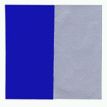On 30 November 2017, the General Court of the European Union (the "General Court") decided a case concerning two EU trade marks consisting of a combination of the colours blue and silver which had previously been invalidated by the Cancellation Division of the European Union Intellectual Property Office ("EUIPO").
On 15 January 2002, Red Bull GmbH ("Red Bull") filed an application for registration of an EU trade mark with EUIPO consisting of a combination of two colours per se, namely blue (RAL 5002) and silver (RAL 9006) (the "First Contested Mark").

Later, on 1 October 2010, Red Bull filed a second application for registration of an EU trade mark with EUIPO for the combination of two colours per se, namely blue (Pantone 2747C) and silver (Pantone 877C) (the "Second Contested Mark", together with the First Contested Mark the "Contested Marks").

By two decisions of 9 October 2013, the Cancellation Division of EUIPO declared both trade marks to be invalid, finding that the graphic representation of those marks constituted the "mere juxtaposition of two or more colours, designated in the abstract and without contours". It did so in accordance with a judgment of the Court of Justice of the European Union (the "ECJ") of 24 June 2004 in Heidelberger Bauchemie (C‑49/02). According to the Cancellation Division, the Contested Marks did not exhibit the qualities of precision and uniformity pursuant to Article 4 of Regulation No 207/2009 (now Article 4 of Regulation 2017/1001 on the European Union trade mark, the "EUTMR").
On 17 October 2013, Red Bull appealed against both decisions. By two decisions of 2 December 2014, the First Board of Appeal of EUIPO dismissed both appeals as unfounded on the basis of the same reasoning.
Upon further appeal, the General Court reached the same conclusion. It referred to Article 4 EUTMR which provides that an EU trade mark may consist of (i) any signs; (ii) capable of being represented graphically; (iii) provided that such signs are capable of distinguishing the goods or services of one undertaking from those of other undertakings.
The General Court then applied the principles of Heidelberger Bauchemie. In this judgment, the ECJ held that, in order to satisfy the conditions of Article 4 EUTMR, a graphic representation of two or more colours, designated in the abstract and without contours, has to be systematically arranged by associating the colours concerned in a predetermined and uniform way in order to rule out numerous different combinations of those colours that would not permit the consumer to perceive and recall a particular combination.
According to the General Court, this reasoning is consistent with (i) the need for the trade mark to be able to fulfil its function as an indication of origin; (ii) the requirement of legal certainty, in the sense that it allows the competent authorities and economic operators to know with clarity and precision the nature of the signs of which a mark consists and the rights of third parties; and (iii) the requirement that the availability of colours should not be restricted by the creation of a monopoly for the benefit of a single firm.
The General Court found that the Board of Appeal was right in concluding that the graphic representation of the Contested Marks consisted of a mere juxtaposition of two colours without shape or contours, allowing several different combinations of the two colours and that the descriptions accompanying the graphical representations did not provide additional precision with regard to the systematic arrangement associating the colours in a predetermined and uniform way and precluding a number of different combinations of those colours.
Furthermore, the General Court rejected Red Bull's claim that the contested decisions violated the principle of equal treatment and the principle of proportionality. According to the General Court, it follows from the nature of colour per se marks that the subject matter of the protection afforded by such marks should be defined in appropriate detail. Consequently, different treatment is justified. As regards the alleged violation of the proportionality principle, the General Court again pointed to the special nature of marks consisting of a combination of colours and concluded that the requirements of clarity and precision are proportionate to the main objective pursued by Article 4 EUTMR, namely to safeguard the function of an EU trade mark as an indication of origin.
Finally, the General Court considered whether the contested decision infringed the principle of protection of legitimate expectations. Referring to its judgment in Interkobo v OHIM – XXXLutz Marken (my baby) (T-523/10) the General Court held that Red Bull could not rely on the acceptance of the description by EUIPO's examiner since "such assurances did not comply with the applicable provisions", namely Article 7 EUTMR (i.e., the 'absolute grounds for refusal'). Accordingly, the acceptance by the examiner could not give rise to a legitimate expectation. Furthermore, the General Court referred to Article 52(1) EUTMR according to which an EU trade mark is to be declared invalid on application to EUIPO or on the basis of a counterclaim in infringement proceedings where the EU trade mark has been registered contrary to the provisions of Article 7 EUTMR. Lastly, the General Court decided that Red Bull could not properly rely on previous decisions of EUIPO. According to the General Court, EUIPO must consider with special care whether it should decide in the same way or not, while taking into account the principles of equal treatment and sound administration and the decisions already taken in respect of similar applications. The way in which those principles are applied must be consistent with respect for legality.
As a result, the General Court upheld the invalidation of Red Bull's silver and blue trade marks.
The content of this article is intended to provide a general guide to the subject matter. Specialist advice should be sought about your specific circumstances.
